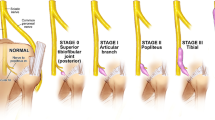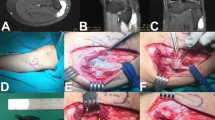Abstract
Background
Intraneural ganglia most commonly occur within the peroneal nerve near the fibular neck. Disconnection of the articular branch is required in their treatment. Surgical intervention can be challenging because of unfamiliarity with the region or scarring from previous surgery.
Method
We present the layered “U” technique for peroneal intraneural ganglia with clinical examples. Dissection is carried down in parallel to the U-shaped course of the articular branch to provide optimal visualization and avoid injury to major branches of the nerve.
Conclusion
This pathoanatomic approach provides direct and safe exposure of the articular branch of the common peroneal nerve.
Key points
• The CPN is the most frequently affected site for IG.
• PIG are becomingly increasingly recognized as causes of foot drop [9].
• PIG can represent an operative challenge, particularly in the setting of previous surgery.
• Understanding the consistent U-shape of the AB and its cystic involvement in PIG allows a more efficient dissection.
• A U-shaped layered approach exposes the AB.
• Dissection superiorly and medially along the AB minimizes risk to the DPN and SPN.
• Disconnection of the AB near the STFJ minimizes intraneural cyst recurrence and is the critical part of the procedure.
• Cyst decompression may expedite symptom relief.
• We have added STFJ resection (disarticulation) to our strategy to further decrease risks for intraneural and extraneural recurrence, as it removes the synovium, the source of STFJ-related ganglia.
• This surgical strategy maximizes neurologic improvement and minimizes cyst recurrence.




Similar content being viewed by others
Abbreviations
- AB:
-
articular branch
- AT:
-
articular trunk
- CPN:
-
common peroneal nerve
- DPN:
-
deep peroneal nerve
- IG:
-
intraneural ganglia
- MRI:
-
magnetic resonance imaging
- PIG:
-
peroneal intraneural ganglia
- PL:
-
peroneus longus
- SPN:
-
superficial peroneal nerve
- STFJ:
-
superior tibiofibular joint
- TA:
-
tibialis anterior
References
Gardner E (1948) The innervation of the knee joint. Anat Rec 101:109–130
Shahid KR, Spinner RJ, Skinner JA, Felmlee JP, Bond JR, Stanley DW, Amrami KK (2010) Evaluation of intraneural ganglion cysts using three-dimensional fast spin echo-cube. J Magn Reson Imaging 32:714–718
Spinner RJ, Atkinson JL, Tiel RL (2003) Peroneal intraneural ganglia: the importance of the articular branch. A unifying theory. J Neurosurg 99:330–343
Spinner RJ, Desy NM, Amrami KK (2006) Cystic transverse limb of the articular branch: a pathognomonic sign for peroneal intraneural ganglia at the superior tibiofibular joint. Neurosurgery 59:157–166
Spinner RJ, Desy NM, Rock MG, Amrami KK (2007) Peroneal intraneural ganglia. Part I. Techniques for successful diagnosis and treatment. Neurosurg Focus 22:E16
Spinner RJ, Desy NM, Rock MG, Amrami KK (2007) Peroneal intraneural ganglia. Part II. Lessons learned and pitfalls to avoid for successful diagnosis and treatment. Neurosurg Focus 22:E27
Spinner RJ, Hébert-Blouin MN, Amrami KK, Rock MG (2010) Peroneal and tibial intraneural ganglion cysts in the knee region: a technical note. Neurosurgery 67:71–78
Spinner RJ, Scheithauer BW, Amrami KK (2009) The unifying articular (synovial) origin of intraneural ganglia: evolution-revelation-revolution. Neurosurgery 65:A115–A124
Visser LH (2006) High-resolution sonography of the common peroneal nerve: detection of intraneural ganglia. Neurology 67:1473–1475
Further Reading
Colombo EV, Howe BM, Amrami KK, Spinner RJ (2014) Elaborating upon the descent phase of fibular and tibial intraneural ganglion cysts after cross-over in the sciatic nerve. Clin Anat 27:1133–1136
Acknowledgments
The authors appreciate the assistance of Dave Factor (Rochester, MN) and Debra J. Zimmer (Buffalo, NY).
Conflict of interest
None
Author information
Authors and Affiliations
Corresponding author
Additional information
Work conducted at the Mayo Clinic, Rochester, MN, USA
Electronic supplementary material
Below is the link to the electronic supplementary material.
Patient 4. Primary surgery for PIG. A 34-year-old male with a complex, multilobulated cyst and a footdrop [1]. With permission of the Mayo Foundation, 2014. (MP4 19129 kb)
Rights and permissions
About this article
Cite this article
Lipinski, L.J., Rock, M.G. & Spinner, R.J. Peroneal intraneural ganglion cysts at the fibular neck: the layered “U” surgical approach to the articular branch and superior tibiofibular joint. Acta Neurochir 157, 837–840 (2015). https://doi.org/10.1007/s00701-014-2323-2
Received:
Accepted:
Published:
Issue Date:
DOI: https://doi.org/10.1007/s00701-014-2323-2




